Overview
After you have trained the model, next step is to save the model to the model catalog, conduct deployment, and then do prediction. This module provides a continuous experience to finish those steps.

Quick Start
GenericModel
import tempfile
from ads.model.generic_model import GenericModel
class Toy:
def predict(self, x):
return x ** 2
estimator = Toy()
model = GenericModel(estimator=estimator, artifact_dir=tempfile.mkdtemp())
model.summary_status()
model.prepare(inference_conda_env="dataexpl_p37_cpu_v3")
model.verify(2)
model.save()
model.deploy()
model.predict(2)
model.delete_deployment()
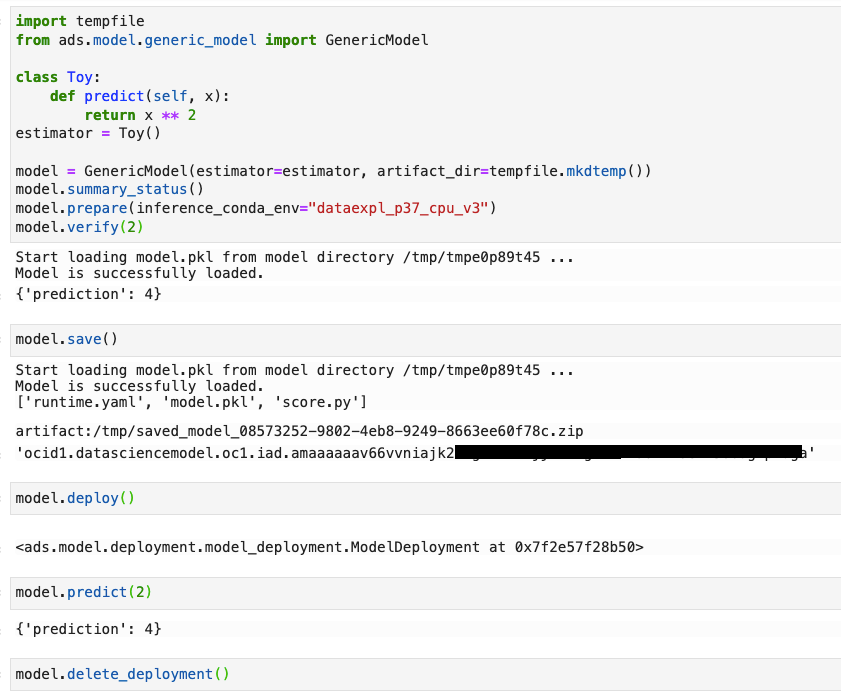
# loading model from a or zip archive.
model = GenericModel.from_model_artifact("/folder_to_your/artifact.zip",
model_file_name="your_model_file_name",
artifact_dir=tempfile.mkdtemp())
model.verify(your_data)
# loading a remote model from the model catalog.
model = GenericModel.from_model_catalog(model_id="ocid1.datasciencemodel.oc1.iad.amaaaa....",
model_file_name="your_model_file_name",
artifact_dir=tempfile.mkdtemp())
model.verify(your_data)
SklearnModel
import tempfile
from sklearn.model_selection import train_test_split
from ads.model.framework.sklearn_model import SklearnModel
from sklearn.linear_model import LogisticRegression
from sklearn.datasets import load_iris
iris = load_iris()
X, y = iris.data, iris.target
X_train, X_test, y_train, y_test = train_test_split(X, y, test_size=0.25)
sklearn_estimator = LogisticRegression()
sklearn_estimator.fit(X_train, y_train)
sklearn_model = SklearnModel(estimator=sklearn_estimator, artifact_dir=tempfile.mkdtemp())
sklearn_model.prepare(inference_conda_env="dataexpl_p37_cpu_v3")
sklearn_model.verify(X_test[:2])
sklearn_model.save()
model_deployment = sklearn_model.deploy()
sklearn_model.predict(X_test[:2])
sklearn_model.delete_deployment()
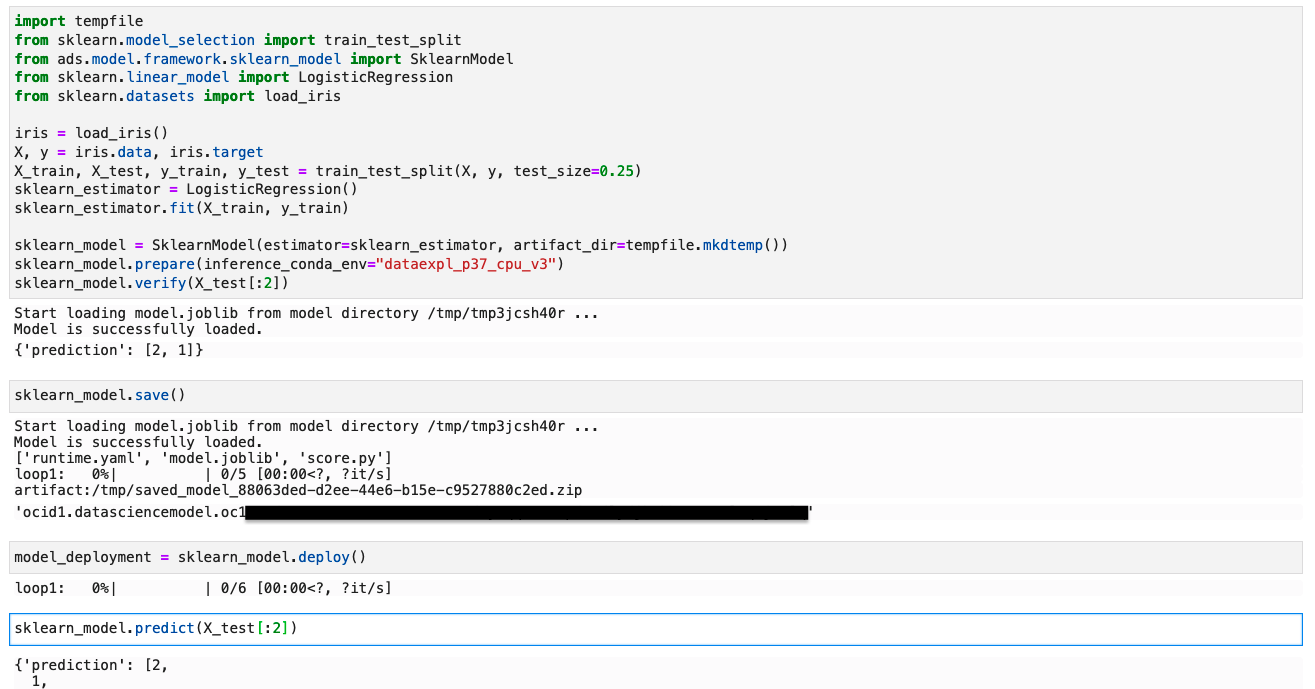
# loading model from a or zip archive.
model = SklearnModel.from_model_artifact("/folder_to_your/artifact.zip",
model_file_name="your_model_file_name",
artifact_dir=tempfile.mkdtemp())
model.verify(your_data)
# loading a remote model from the model catalog.
model = SklearnModel.from_model_catalog(model_id="ocid1.datasciencemodel.oc1.iad.amaaaa....",
model_file_name="your_model_file_name",
artifact_dir=tempfile.mkdtemp())
model.verify(your_data)
XGBoostModel
import xgboost as xgb
import tempfile
from sklearn.datasets import make_classification
from sklearn.model_selection import train_test_split
from sklearn.datasets import load_iris
from ads.model.framework.xgboost_model import XGBoostModel
iris = load_iris()
X, y = iris.data, iris.target
X_train, X_test, y_train, y_test = train_test_split(X, y, test_size=0.25)
xgboost_estimator = xgb.XGBClassifier()
xgboost_estimator.fit(X_train, y_train)
xgboost_model = XGBoostModel(estimator=xgboost_estimator, artifact_dir=tempfile.mkdtemp())
xgboost_model.prepare(inference_conda_env="generalml_p37_cpu_v1")
xgboost_model.verify(X_test[:2])
xgboost_model.save()
model_deployment = xgboost_model.deploy()
xgboost_model.predict(X_test[:2])
xgboost_model.delete_deployment()


# loading model from a or zip archive.
model = XGBoostModel.from_model_artifact("/folder_to_your/artifact.zip",
model_file_name="your_model_file_name",
artifact_dir=tempfile.mkdtemp())
model.verify(your_data)
# loading a remote model from the model catalog.
model = XGBoostModel.from_model_catalog(model_id="ocid1.datasciencemodel.oc1.iad.amaaaa....",
model_file_name="your_model_file_name",
artifact_dir=tempfile.mkdtemp())
model.verify(your_data)
LightGBMModel
import lightgbm as lgb
import tempfile
from sklearn.model_selection import train_test_split
from sklearn.datasets import load_iris
from ads.model.framework.lightgbm_model import LightGBMModel
iris = load_iris()
X, y = iris.data, iris.target
X_train, X_test, y_train, y_test = train_test_split(X, y, test_size=0.25)
train = lgb.Dataset(X_train, label=y_train)
param = {
'objective': 'multiclass', 'num_class': 3,
}
lightgbm_estimator = lgb.train(param, train)
lightgbm_model = LightGBMModel(estimator=lightgbm_estimator, artifact_dir=tempfile.mkdtemp())
lightgbm_model.prepare(inference_conda_env="generalml_p37_cpu_v1")
lightgbm_model.verify(X_test[:2])
lightgbm_model.save()
model_deployment = lightgbm_model.deploy()
lightgbm_model.predict(X_test[:2])
lightgbm_model.delete_deployment()


# loading model from a or zip archive.
model = LightGBMModel.from_model_artifact("/folder_to_your/artifact.zip",
model_file_name="your_model_file_name",
artifact_dir=tempfile.mkdtemp())
model.verify(your_data)
# loading a remote model from the model catalog.
model = LightGBMModel.from_model_catalog(model_id="ocid1.datasciencemodel.oc1.iad.amaaaa....",
model_file_name="your_model_file_name",
artifact_dir=tempfile.mkdtemp())
model.verify(your_data)
PyTorchModel
from ads.model.framework.pytorch_model import PyTorchModel
import tempfile
import torch
import torchvision
torch_estimator = torchvision.models.resnet18(pretrained=True)
torch_estimator.eval()
# create fake test data
test_data = torch.randn(1, 3, 224, 224)
artifact_dir = tempfile.mkdtemp()
torch_model = PyTorchModel(torch_estimator, artifact_dir=artifact_dir)
torch_model.prepare(inference_conda_env="computervision_p37_cpu_v1")
# Update ``score.py`` by constructing the model class instance first.
added_line = """
import torchvision
the_model = torchvision.models.resnet18()
"""
with open(artifact_dir + "/score.py", 'r+') as f:
content = f.read()
f.seek(0, 0)
f.write(added_line.rstrip('\r\n') + '\n' + content)
# continue to save and deploy the model.
torch_model.verify(test_data)
torch_model.save(timeout=200)
model_deployment = torch_model.deploy()
torch_model.predict(test_data)
torch_model.delete_deployment()
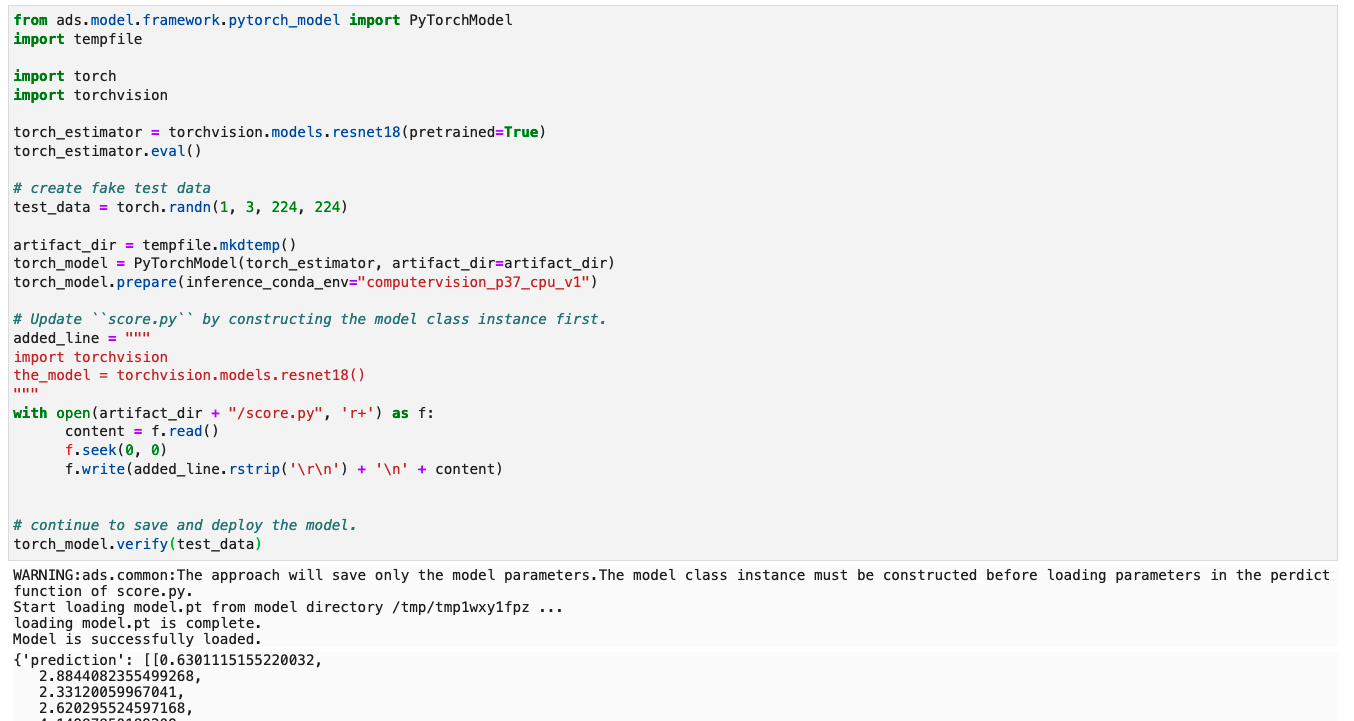

# loading model from a or zip archive.
model = PyTorchModel.from_model_artifact("/folder_to_your/artifact.zip",
model_file_name="your_model_file_name",
artifact_dir=tempfile.mkdtemp())
model.verify(your_data)
# loading a remote model from the model catalog.
model = PyTorchModel.from_model_catalog(model_id="ocid1.datasciencemodel.oc1.iad.amaaaa....",
model_file_name="your_model_file_name",
artifact_dir=tempfile.mkdtemp())
model.verify(your_data)
TensorFlowModel
from ads.model.framework.tensorflow_model import TensorFlowModel
import tempfile
import tensorflow as tf
mnist = tf.keras.datasets.mnist
(x_train, y_train), (x_test, y_test) = mnist.load_data()
x_train, x_test = x_train / 255.0, x_test / 255.0
tf_estimator = tf.keras.models.Sequential(
[
tf.keras.layers.Flatten(input_shape=(28, 28)),
tf.keras.layers.Dense(128, activation="relu"),
tf.keras.layers.Dropout(0.2),
tf.keras.layers.Dense(10),
]
)
loss_fn = tf.keras.losses.SparseCategoricalCrossentropy(from_logits=True)
tf_estimator.compile(optimizer="adam", loss=loss_fn, metrics=["accuracy"])
tf_estimator.fit(x_train, y_train, epochs=1)
tf_model = TensorFlowModel(tf_estimator, artifact_dir=tempfile.mkdtemp())
tf_model.prepare(inference_conda_env="generalml_p37_cpu_v1")
tf_model.verify(x_test[:1])
tf_model.save()
model_deployment = tf_model.deploy()
tf_model.predict(x_test[:1])
tf_model.delete_deployment()
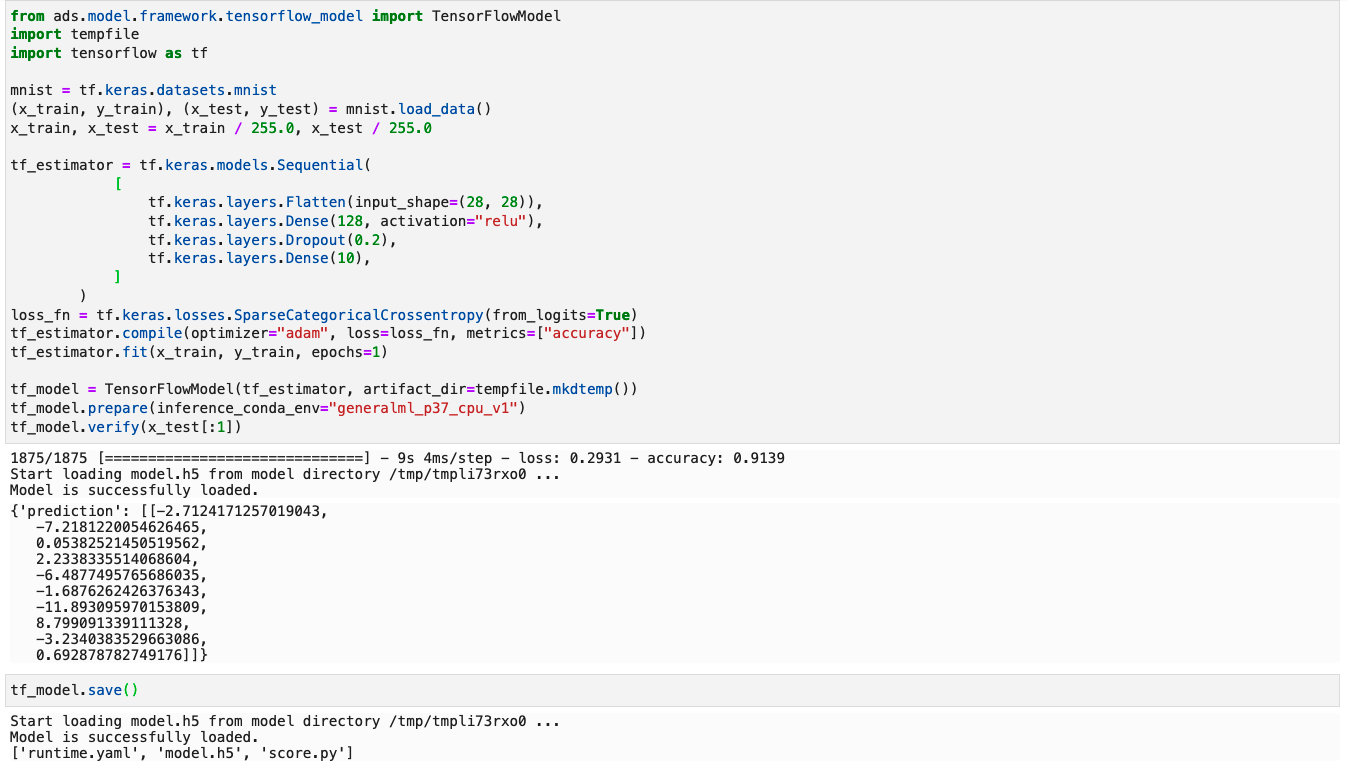

# loading model from a or zip archive.
model = TensorFlowModel.from_model_artifact("/folder_to_your/artifact.zip",
model_file_name="your_model_file_name",
artifact_dir=tempfile.mkdtemp())
model.verify(your_data)
# loading a remote model from the model catalog.
model = TensorFlowModel.from_model_catalog(model_id="ocid1.datasciencemodel.oc1.iad.amaaaa....",
model_file_name="your_model_file_name",
artifact_dir=tempfile.mkdtemp())
model.verify(your_data)
AutoMLModel
import tempfile
import logging
import warnings
from ads.automl.driver import AutoML
from ads.automl.provider import OracleAutoMLProvider
from ads.dataset.dataset_browser import DatasetBrowser
from ads.model.framework.automl_model import AutoMLModel
from ads.common.model_metadata import UseCaseType
ds = DatasetBrowser.sklearn().open("wine").set_target("target")
train, test = ds.train_test_split(test_size=0.1, random_state = 42)
ml_engine = OracleAutoMLProvider(n_jobs=-1, loglevel=logging.ERROR)
oracle_automl = AutoML(train, provider=ml_engine)
model, baseline = oracle_automl.train(
model_list=['LogisticRegression', 'DecisionTreeClassifier'],
random_state = 42,
time_budget = 500
)
artifact_dir = tempfile.mkdtemp()
automl_model = AutoMLModel(estimator=model, artifact_dir=artifact_dir)
automl_model.prepare(inference_conda_env="generalml_p37_cpu_v1",
training_conda_env="generalml_p37_cpu_v1",
use_case_type=UseCaseType.BINARY_CLASSIFICATION,
X_sample=test.X,
force_overwrite=True)
automl_model.verify(test.X.iloc[:10])
model_id = automl_model.save(display_name='Demo AutoMLModel model')
deploy = automl_model.deploy(display_name='Demo AutoMLModel deployment')
automl_model.predict(test.X.iloc[:10])
automl_model.delete_deployment()
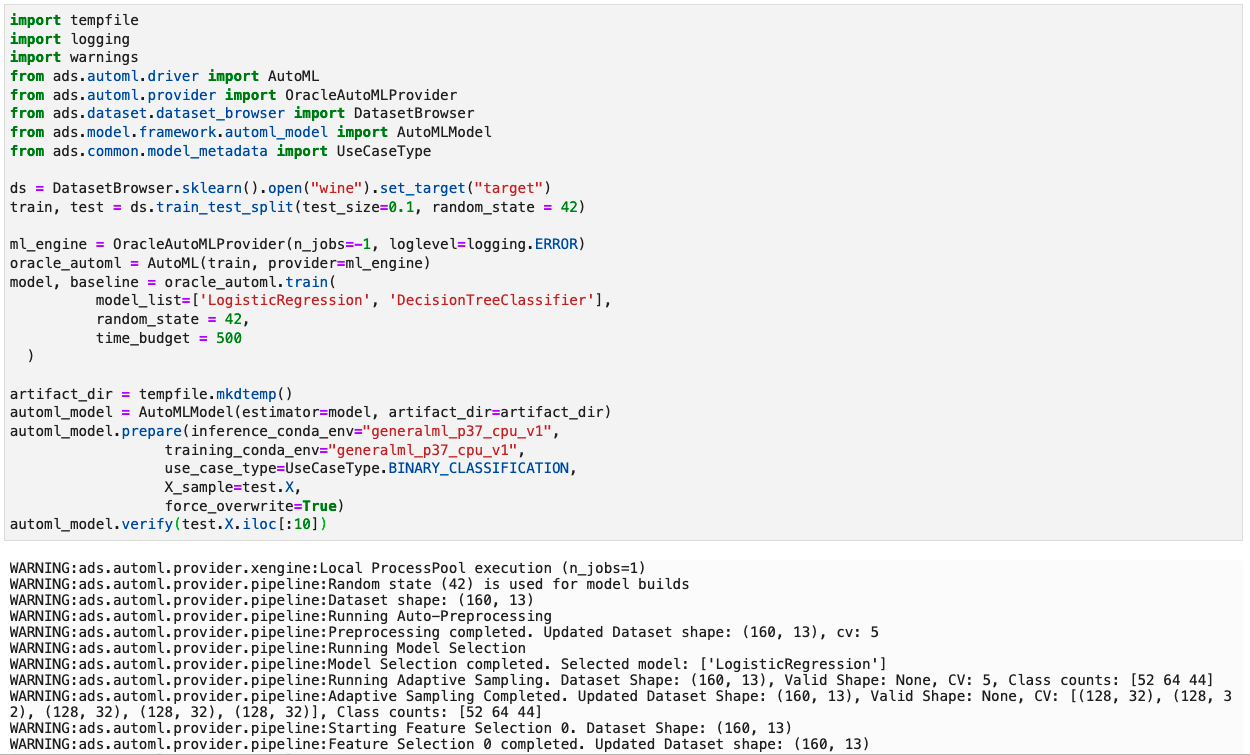
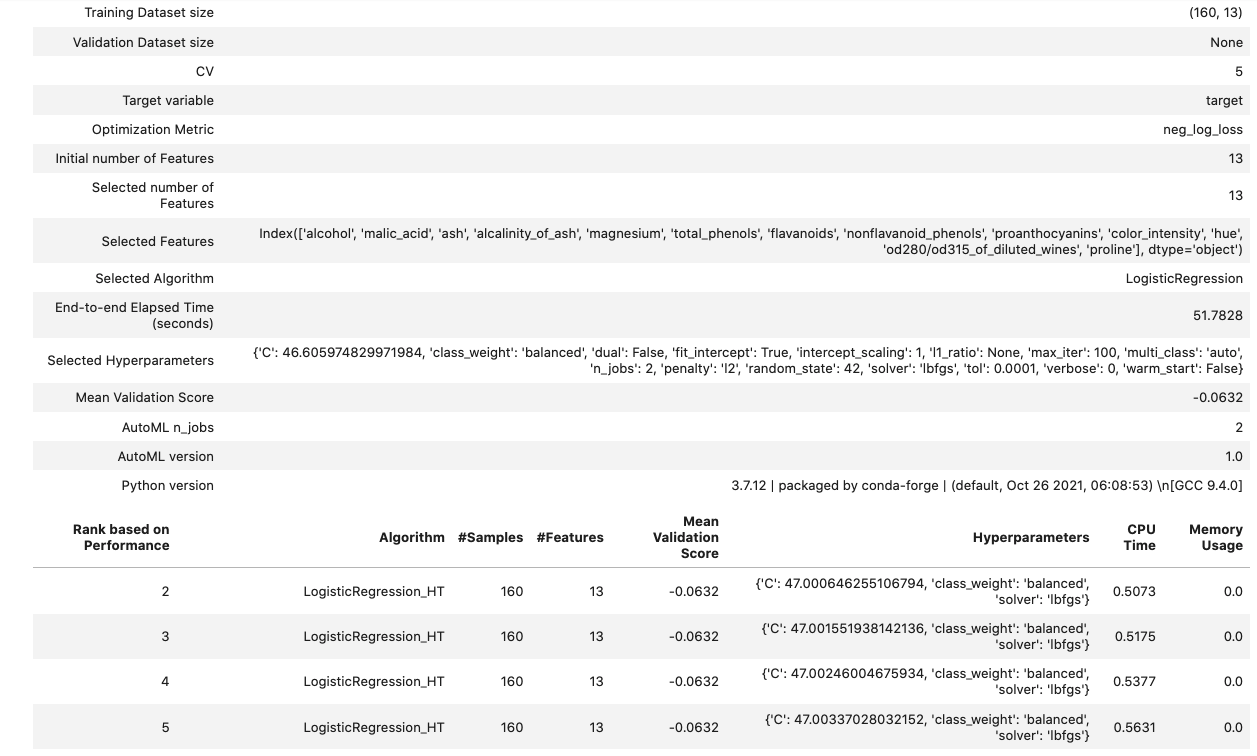
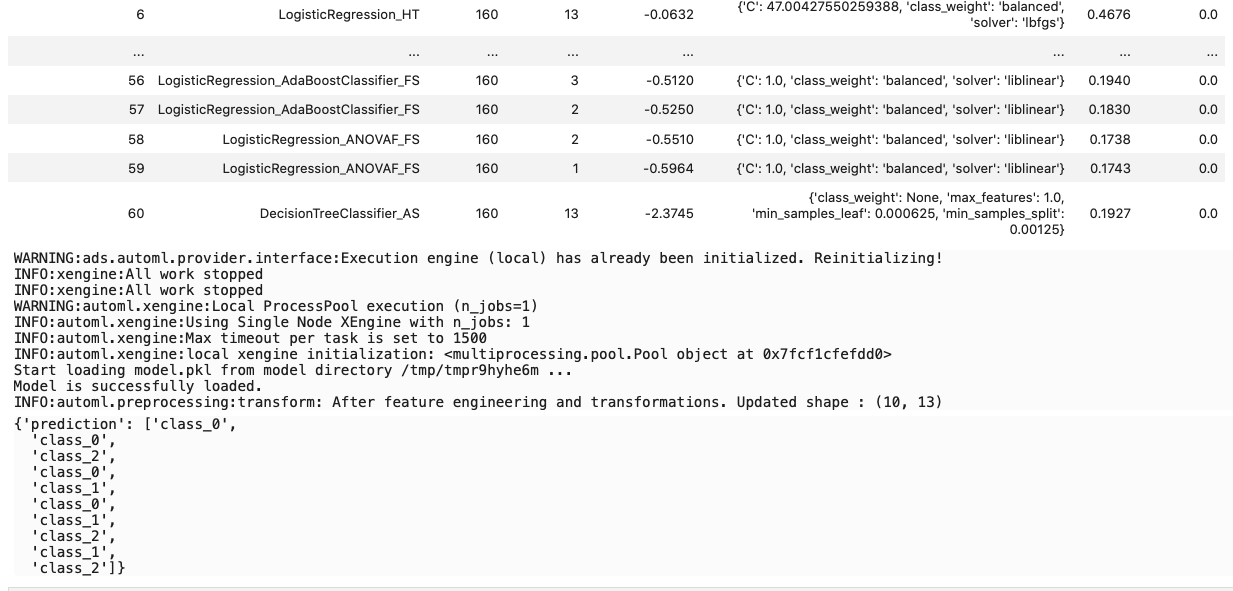

# loading model from a or zip archive.
model = AutoMLModel.from_model_artifact("/folder_to_your/artifact.zip",
model_file_name="your_model_file_name",
artifact_dir=tempfile.mkdtemp())
model.verify(your_data)
# loading a remote model from the model catalog.
model = AutoMLModel.from_model_catalog(model_id="ocid1.datasciencemodel.oc1.iad.amaaaa....",
model_file_name="your_model_file_name",
artifact_dir=tempfile.mkdtemp())
model.verify(your_data)